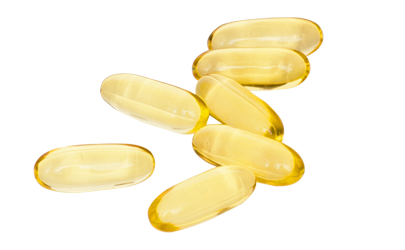
What is Omega-3?
Omega-3 fatty acids are a group of essential polyunsaturated fats that play crucial roles in the body. They are termed essential because the body cannot produce them on its own — they must be obtained through diet or supplements.
There are three main types of Omega-3 fatty acids:
- ALA (Alpha-linolenic acid) – found in plant oils.
- EPA (Eicosapentaenoic acid) – found in marine oils.
- DHA (Docosahexaenoic acid) – also found in marine oils and is particularly important for brain and eye health.
What Does Omega-3 Contain?
Omega-3 fatty acids are chains of carbon atoms with double bonds located at the third carbon from the end of the chain — hence the name "omega-3." Their structure gives them unique properties:
- Anti-inflammatory effects
- Fluidity in cell membranes
- Precursor to signaling molecules called eicosanoids
EPA and DHA are considered more biologically active than ALA, though ALA can be converted (in small amounts) to EPA and DHA in the body.
How Does Omega-3 Help the Body?
Omega-3 fatty acids contribute to health in numerous ways:
- Reduces triglycerides
- Lowers blood pressure
- Decreases risk of arrhythmias
- Prevents plaque buildup in arteries
- Improves HDL (good cholesterol)
1. Heart Health
2. Brain and Cognitive Function
- DHA is a major component of brain tissue.
- Enhances cognitive function and memory
- Reduces risk of Alzheimer’s and age-related decline
- Supports mental health; reduces symptoms of depression and anxiety
3. Inflammation and Autoimmune Diseases
- EPA and DHA reduce chronic inflammation
- Useful in conditions like rheumatoid arthritis, lupus, psoriasis, and inflammatory bowel diseases
4. Eye Health
- DHA is critical for retina development and function
- May reduce the risk of macular degeneration
5. Pregnancy and Infant Development
- Supports brain and eye development in fetuses and infants
- May improve cognitive and motor development in children
6. Skin Health
- Maintains skin hydration and elasticity
- Reduces acne and prevents premature aging
7. Joint and Bone Health
- Reduces joint pain and stiffness
- Improves bone strength by enhancing calcium absorption
What Happens in the Body When You Consume Omega-3?
- Omega-3s are absorbed in the small intestine and incorporated into chylomicrons (fat transport molecules).
- These are then transported through the lymphatic system and bloodstream to tissues.
Absorption & Transport
- EPA and DHA are integrated into the phospholipid bilayer of cells, improving membrane fluidity and function.
Cell Membrane Integration
- Omega-3s act as precursors to resolvins and protectins, compounds that resolve inflammation.
- They also compete with omega-6 fats to produce less inflammatory eicosanoids.
Anti-inflammatory Response
- Omega-3s can influence gene expression related to fat metabolism, inflammation, and cell growth.
Gene Expression
Natural Sources of Omega-3
- Flaxseeds and flaxseed oil
- Chia Seeds
- Walnuts
- Hemp seeds
- canola Oil
- Soybeans and soybean oil
Plant-Based Sources (High in ALA):
- Fatty fish (salmon, mackerel, sardines, anchovies, herring)
- Cod Liver Oil
- Shellfish (e.g., oysters)
- Algae oil (a vegan source of DHA/EPA)
Marine Sources (High in EPA and DHA):
- Omega-3-enriched eggs
- Fortified dairy products
- Some plant-based milks and spreads
Other Fortified Sources:
| Feature | Omega-3 | Omega-6 |
|---|---|---|
| Type | Polyunsaturated fatty acid | Polyunsaturated fatty acid |
| Common Types | ALA, EPA, DHA | Linoleic acid (LA), Arachidonic acid (AA) |
| Found In | Fish, flaxseed, chia, walnuts | Vegetable oils (corn, sunflower, soybean), processed foods |
| Role in Body | Anti-inflammatory, heart and brain health | Pro-inflammatory (in excess), needed for growth and repair |
| Health Impact | Reduces chronic disease risk | Can promote inflammation if over-consumed |
| Ideal Ratio (O6:O3) | ~4:1 or lower | Modern diets often 15:1 or higher (too much omega-6) |
Key Point: Both Omega-3 and Omega-6 are essential, but a balanced ratio is crucial. Western diets tend to be overly high in omega-6, which can exacerbate inflammation.
Conclusion:
Omega-3 fatty acids are vital to overall health, from the brain and heart to joints and skin. The key to reaping their full benefits is consistent intake through diet or supplements, especially EPA and DHA. Balancing omega-3 and omega-6 intake is also essential to reduce inflammation and promote long-term well-being.
Consider adding Omega-3-rich foods to your meals or speaking with a healthcare provider about supplementation
Disclaimer:
The information provided in this article is for educational and informational purposes only and does not constitute medical, dermatological, or professional advice. Always consult a qualified healthcare provider or dermatologist for personalized guidance regarding skin conditions, hyperpigmentation, or health concerns.
Disclosure: As an Amazon Associate, We earn from qualifying purchases. Product prices and availability are accurate as of the date/time indicated and are subject to change.
Lactic Acid
HERE
LEAVE A REPLY
Your email address will not be published. Required fields are marked *
Fast Delivery
Across West & East India
safe payment
100% Secure Payment
Online Discount
Add Multi-buy Discount
Help Center
Dedicated 24/7 Support
Curated items
From Handpicked Sellers





LEAVE A COMMENTs
Caroline Penny
“This article finally helped me understand the difference between Omega-3 and Omega-6. I used to think all fats were bad — thanks for clearing that up!”
Hudson Matthew
“I’ve been taking fish oil supplements for months but didn’t really know what they did until now. Great breakdown of how it works inside the body!”
Angelika John
“Love that you included plant-based sources of Omega-3! As a vegan, it’s always a challenge finding the right nutrients.”